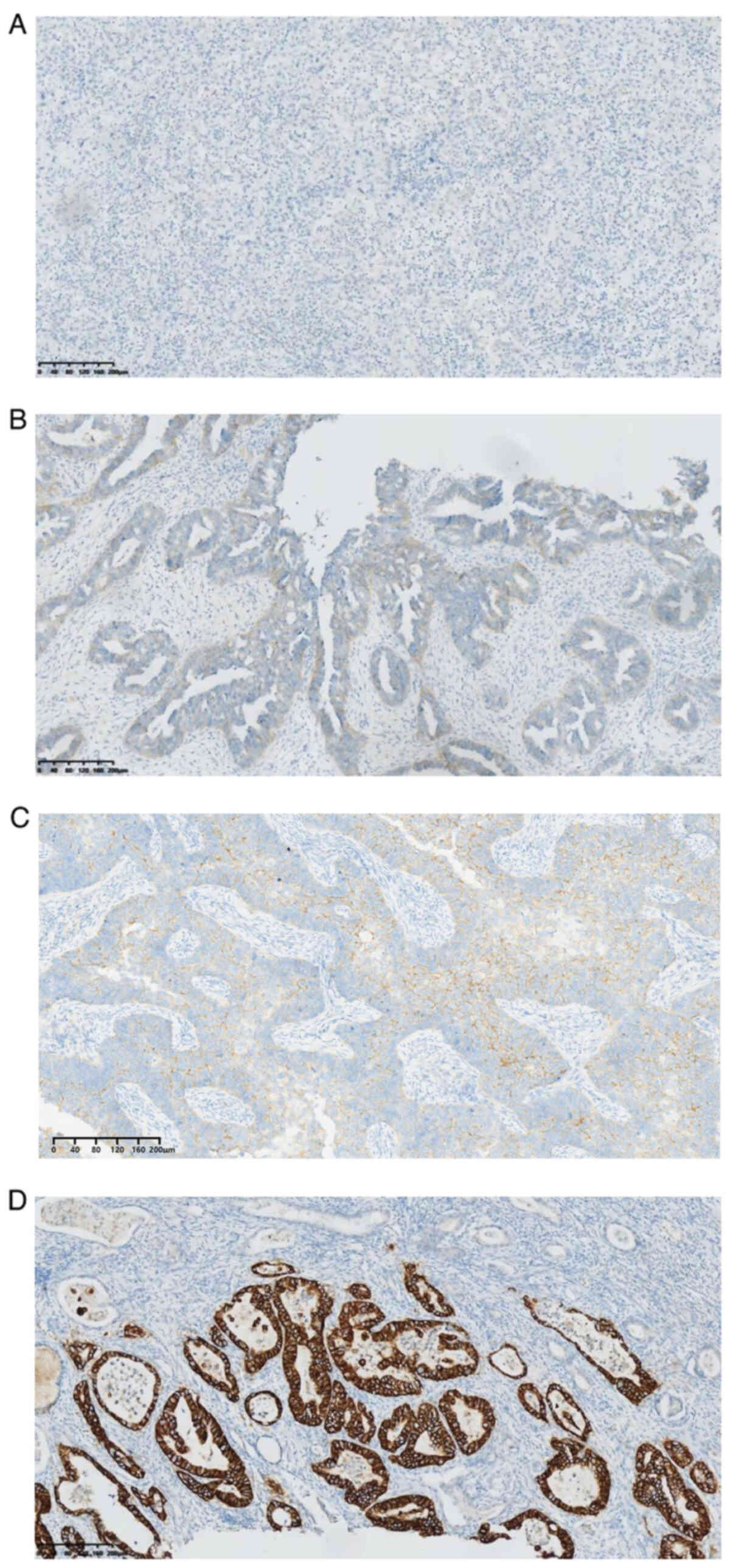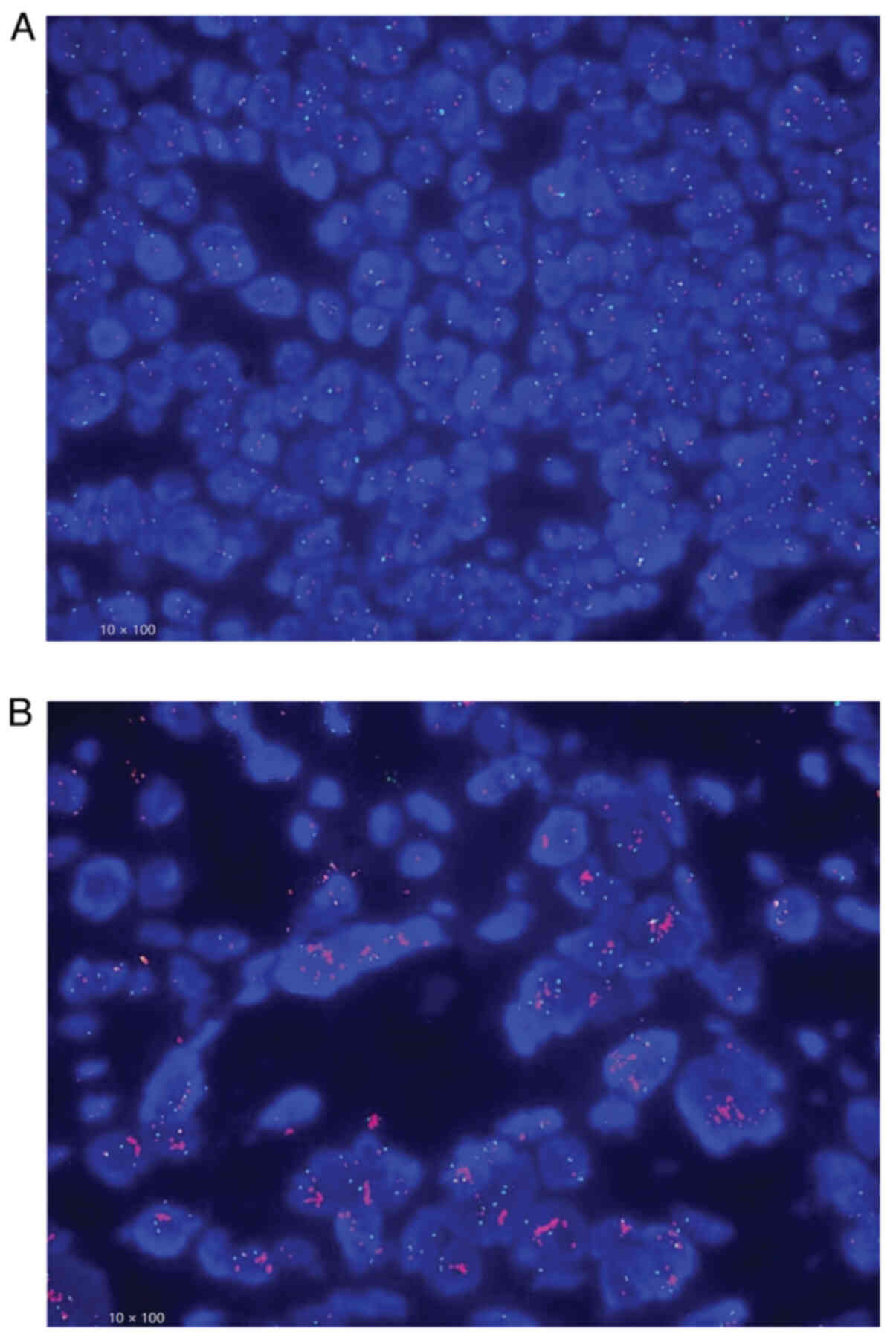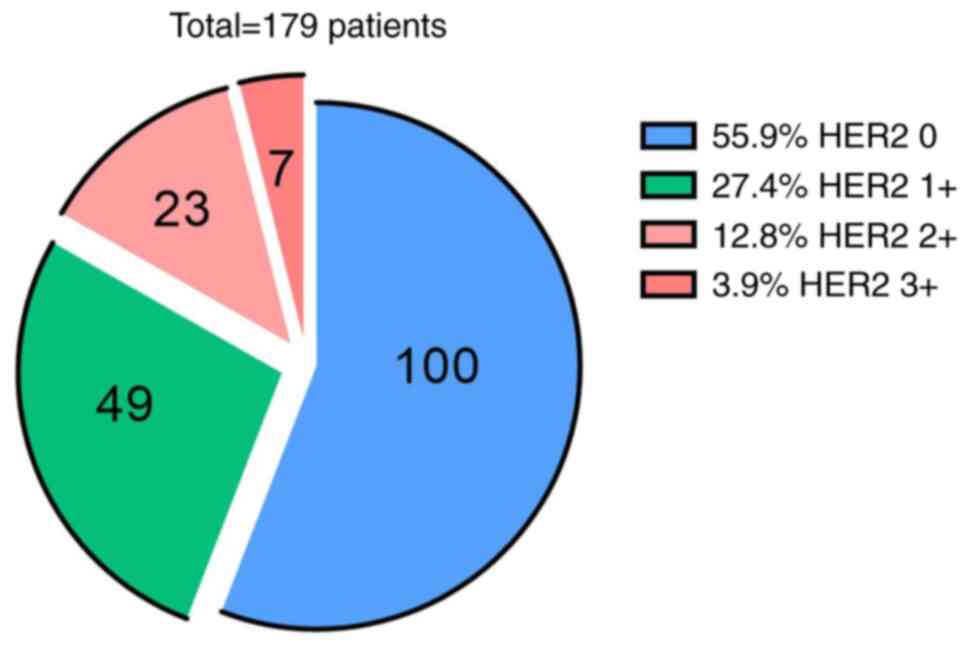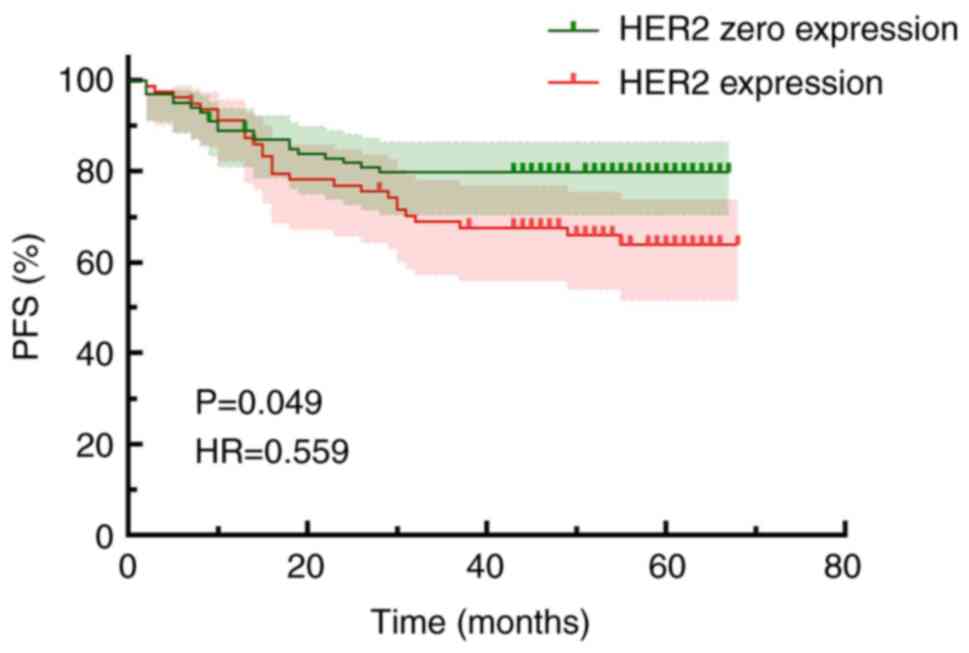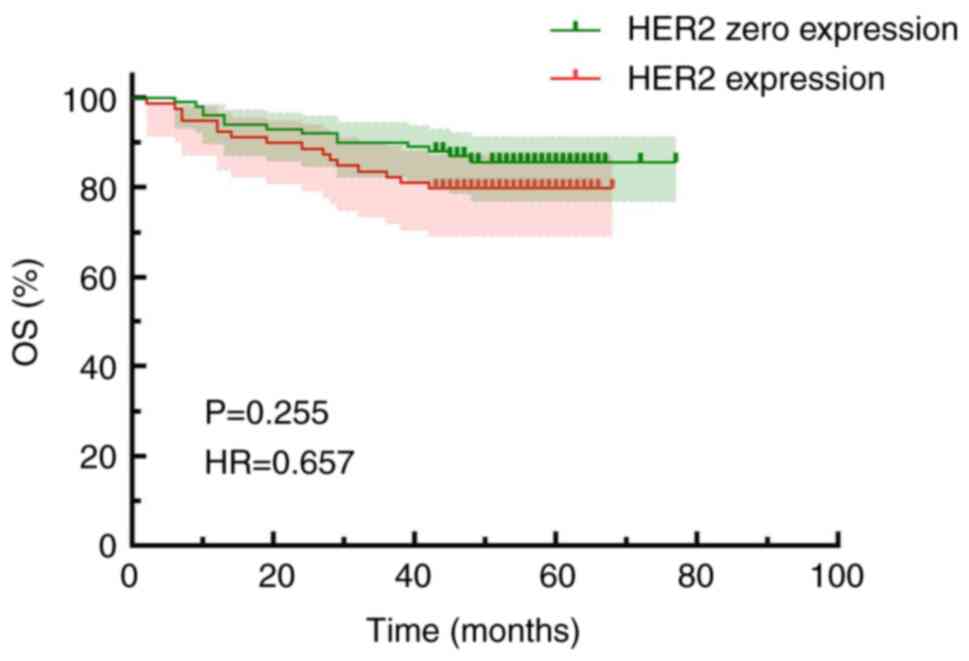|
1
|
Sung H, Ferlay J, Siegel RL, Laversanne M,
Soerjomataram I, Jemal A and Bray F: Global Cancer Statistics 2020:
GLOBOCAN estimates of incidence and mortality worldwide for 36
cancers in 185 countries. CA Cancer J Clin. 71:209–249. 2021.
View Article : Google Scholar : PubMed/NCBI
|
|
2
|
Albadri ST and Salomão D: Metastatic
prostate adenocarcinoma to cervical lymph nodes: An unusual
diagnosis on fine-needle aspiration biopsy. J Am Soc Cytopathol.
10:231–238. 2021. View Article : Google Scholar : PubMed/NCBI
|
|
3
|
Saida T, Sakata A, Tanaka YO, Ochi H,
Ishiguro T, Sakai M, Takahashi H, Satoh T and Minami M: Clinical
and MRI characteristics of uterine cervical adenocarcinoma: Its
variants and mimics. Korean J Radiol. 20:364–377. 2019. View Article : Google Scholar : PubMed/NCBI
|
|
4
|
Gadducci A, Guerrieri ME and Cosio S:
Adenocarcinoma of the uterine cervix: Pathologic features,
treatment options, clinical outcome and prognostic variables. Crit
Rev Oncol Hematol. 135:103–114. 2019. View Article : Google Scholar : PubMed/NCBI
|
|
5
|
Quinn MA, Benedet JL, Odicino F,
Maisonneuve P, Beller U, Creasman WT, Heintz AP, Ngan HY and
Pecorelli S: Carcinoma of the cervix uteri. FIGO 26th Annual Report
on the results of treatment in gynecological cancer. Int J Gynaecol
Obstet. 95 (Suppl 1):S43–S103. 2006.
|
|
6
|
Xie Y, Kong W, Zhao X, Zhang H, Luo D and
Chen S: Immune checkpoint inhibitors in cervical cancer: Current
status and research progress. Front Oncol. 12:9848962022.
View Article : Google Scholar : PubMed/NCBI
|
|
7
|
Yu J, Fang T, Yun C, Liu X and Cai X:
Antibody-drug conjugates targeting the human epidermal growth
factor receptor family in cancers. Front Mol Biosci. 9:8478352022.
View Article : Google Scholar : PubMed/NCBI
|
|
8
|
Zhan N, Dong WG, Tang YF, Wang ZS and
Xiong CL: Analysis of HER2 gene amplification and protein
expression in esophageal squamous cell carcinoma. Med Oncol.
29:933–940. 2012. View Article : Google Scholar : PubMed/NCBI
|
|
9
|
Slamon DJ, Clark GM, Wong SG, Levin WJ,
Ullrich A and McGuire WL: Human breast cancer: Correlation of
relapse and survival with amplification of the HER-2/neu oncogene.
Science. 235:177–182. 1987. View Article : Google Scholar : PubMed/NCBI
|
|
10
|
Seshadri R, Firgaira FA, Horsfall DJ,
McCaul K, Setlur V and Kitchen P: Clinical significance of
HER-2/neu oncogene amplification in primary breast cancer. The
South Australian Breast Cancer Study Group. J Clin Oncol.
11:1936–1942. 1993. View Article : Google Scholar : PubMed/NCBI
|
|
11
|
Jørgensen JT and Hersom M: HER2 as a
prognostic marker in gastric cancer-a systematic analysis of data
from the literature. J Cancer. 3:137–144. 2012. View Article : Google Scholar : PubMed/NCBI
|
|
12
|
Park DI, Yun JW, Park JH, Oh SJ, Kim HJ,
Cho YK, Sohn CI, Jeon WK, Kim BI, Yoo CH, et al: HER-2/neu
amplification is an independent prognostic factor in gastric
cancer. Dig Dis Sci. 51:1371–1379. 2006. View Article : Google Scholar : PubMed/NCBI
|
|
13
|
Shimozaki K, Fukuoka S, Ooki A and
Yamaguchi K: HER2-low gastric cancer: Is the subgroup targetable?
ESMO Open. 9:1036792024. View Article : Google Scholar : PubMed/NCBI
|
|
14
|
Harbeck N: Advances in targeting
HER2-positive breast cancer. Curr Opin Obstet Gynecol. 30:55–59.
2018. View Article : Google Scholar : PubMed/NCBI
|
|
15
|
Bang YJ, Van Cutsem E, Feyereislova A,
Chung HC, Shen L, Sawaki A, Lordick F, Ohtsu A, Omuro Y, Satoh T,
et al: Trastuzumab in combination with chemotherapy versus
chemotherapy alone for treatment of HER2-positive advanced gastric
or gastro-oesophageal junction cancer (ToGA): A phase 3,
open-label, randomised controlled trial. Lancet. 376:687–697. 2010.
View Article : Google Scholar : PubMed/NCBI
|
|
16
|
Kunos CA, Fabian D, Piecoro DW, Napier D,
Miller RW and Ueland FR: Human epidermal growth factor receptor 2
expression in women with uterine cervix adenocarcinoma from
Appalachian Kentucky. Front Oncol. 13:9483482023. View Article : Google Scholar : PubMed/NCBI
|
|
17
|
Shi H, Shao Y, Lu W and Lu B: An analysis
of HER2 amplification in cervical adenocarcinoma: Correlation with
clinical outcomes and the International Endocervical Adenocarcinoma
Criteria and Classification. J Pathol Clin Res. 7:86–95. 2021.
View Article : Google Scholar : PubMed/NCBI
|
|
18
|
Friedman CF, D'Souza A, Bello Roufai D,
Tinker AV, de Miguel M, Gambardella V, Goldman J, Loi S, Melisko
ME, Oaknin A, et al: Targeting HER2-mutant metastatic cervical
cancer with neratinib: Final results from the phase 2 SUMMIT basket
trial. Gynecol Oncol. 181:162–169. 2024. View Article : Google Scholar : PubMed/NCBI
|
|
19
|
Liu J, Zhuo Y, Wang F, Li Z, Lin Y, Li L,
Pan J, Song Y, Du H, Li C and Xu Q: A metastatic cervical
adenocarcinoma patient carrying HER2 G292R achieved complete
response upon pyrotinib treatment. Onco Targets Ther. 14:4833–4836.
2021. View Article : Google Scholar : PubMed/NCBI
|
|
20
|
Martinho O, Silva-Oliveira R, Cury FP,
Barbosa AM, Granja S, Evangelista AF, Marques F, Miranda-Gonçalves
V, Cardoso-Carneiro D, de Paula FE, et al: HER family receptors are
important theranostic biomarkers for cervical cancer: Blocking
glucose metabolism enhances the therapeutic effect of HER
inhibitors. Theranostics. 7:717–732. 2017. View Article : Google Scholar : PubMed/NCBI
|
|
21
|
Dang HZ, Yu Y and Jiao SC: Prognosis of
HER2 over-expressing gastric cancer patients with liver metastasis.
World J Gastroenterol. 18:2402–2407. 2012. View Article : Google Scholar : PubMed/NCBI
|
|
22
|
He Y, Su Y and Zhou L: Expression of HER2
and BRCA1 correlates with prognosis in patients with breast cancer
after radiotherapy: A Case-control study. Cancer Biother
Radiopharm. 37:603–611. 2022.PubMed/NCBI
|
|
23
|
Van Cutsem E, Bang YJ, Feng-Yi F, Xu JM,
Lee KW, Jiao SC, Chong JL, López-Sanchez RI, Price T, Gladkov O, et
al: HER2 screening data from ToGA: Targeting HER2 in gastric and
gastroesophageal junction cancer. Gastric Cancer. 18:476–484. 2015.
View Article : Google Scholar : PubMed/NCBI
|
|
24
|
Wang Y, Gong J, Wang A, Wei J, Peng Z,
Wang X, Zhou J, Qi C, Liu D, Li J, et al: Disitamab vedotin (RC48)
plus toripalimab for HER2-expressing advanced gastric or
gastroesophageal junction and other solid tumours: A multicentre,
open label, dose escalation and expansion phase 1 trial.
EClinicalMedicine. 68:1024152024. View Article : Google Scholar : PubMed/NCBI
|
|
25
|
Lingying W, Li G, Zhang Y, An R, Sun L,
Zhang K, Huang Y, Guo R, Li Q, Miao J, et al: Evaluation of the
effectiveness and safety of disitamab vedotin For HER2-expressing
recurrent cervical cancer after progression on platinum-based
treatment-a single-arm, multicenter, open-label, phase II clinical
study. Int J Gynecological Cancer. 34 (Suppl 1):A6.1–A6. 2024.
|
|
26
|
Nicolò E, Boscolo Bielo L, Curigliano G
and Tarantino P: The HER2-low revolution in breast oncology: Steps
forward and emerging challenges. Ther Adv Med Oncol.
15:175883592311528422023. View Article : Google Scholar : PubMed/NCBI
|
|
27
|
Schildhaus HU: Immunohistochemistry-based
predictive biomarkers for lung cancer. Pathologe. 41:21–31.
2020.(In German). View Article : Google Scholar : PubMed/NCBI
|
|
28
|
Swain SM, Miles D, Kim SB, Im YH, Im SA,
Semiglazov V, Ciruelos E, Schneeweiss A, Loi S, Monturus E, et al:
Pertuzumab, trastuzumab, and docetaxel for HER2-positive metastatic
breast cancer (CLEOPATRA): End-of-study results from a
double-blind, randomised, placebo-controlled, phase 3 study. Lancet
Oncol. 21:519–530. 2020. View Article : Google Scholar : PubMed/NCBI
|
|
29
|
Kim H and Chung JH: PD-L1 Testing in
Non-small cell lung cancer: Past, present, and future. J Pathol
Transl Med. 53:199–206. 2019. View Article : Google Scholar : PubMed/NCBI
|
|
30
|
Huang X, Ding Q, Guo H, Gong Y, Zhao J,
Zhao M, Sui D, Wu Y, Chen H, Liu H, et al: Comparison of three
FDA-approved diagnostic immunohistochemistry assays of PD-L1 in
triple-negative breast carcinoma. Hum Pathol. 108:42–50. 2021.
View Article : Google Scholar : PubMed/NCBI
|
|
31
|
Bartley AN, Washington MK, Colasacco C,
Ventura CB, Ismaila N, Benson AB III, Carrato A, Gulley ML, Jain D,
Kakar S, et al: HER2 testing and clinical decision making in
gastroesophageal adenocarcinoma: Guideline from the college of
american pathologists, american society for clinical pathology, and
the american society of clinical oncology. J Clin Oncol.
35:446–464. 2017. View Article : Google Scholar : PubMed/NCBI
|
|
32
|
Vakiani E: HER2 testing in gastric and
gastroesophageal adenocarcinomas. Adv Anat Pathol. 22:194–201.
2015. View Article : Google Scholar : PubMed/NCBI
|
|
33
|
Hoang MP, Sahin AA, Ordòñez NG and Sneige
N: HER-2/neu gene amplification compared with HER-2/neu protein
overexpression and interobserver reproducibility in invasive breast
carcinoma. Am J Clin Pathol. 113:852–859. 2000. View Article : Google Scholar : PubMed/NCBI
|
|
34
|
Zhou J, Chen Y, Xu X, Yan D and Lou H:
Postoperative clinicopathological factors affecting cervical
adenocarcinoma: Stages I–IIB. Medicine (Baltimore). 97:e93232018.
View Article : Google Scholar : PubMed/NCBI
|
|
35
|
Dieci MV, Miglietta F, Griguolo G and
Guarneri V: Biomarkers for HER2-positive metastatic breast cancer:
Beyond hormone receptors. Cancer Treat Rev. 88:1020642020.
View Article : Google Scholar : PubMed/NCBI
|
|
36
|
Sawaki A, Ohashi Y, Omuro Y, Satoh T,
Hamamoto Y, Boku N, Miyata Y, Takiuchi H, Yamaguchi K, Sasaki Y, et
al: Efficacy of trastuzumab in Japanese patients with HER2-positive
advanced gastric or gastroesophageal junction cancer: A subgroup
analysis of the Trastuzumab for Gastric Cancer (ToGA) study.
Gastric Cancer. 15:313–322. 2012. View Article : Google Scholar : PubMed/NCBI
|
|
37
|
Abu-Rustum NR, Yashar CM, Arend R, Barber
E, Bradley K, Brooks R, Campos SM, Chino J, Chon HS, Crispens MA,
et al: NCCN Guidelines® Insights: Cervical cancer,
version 1.2024. J Natl Compr Canc Netw. 21:1224–1233. 2023.
View Article : Google Scholar : PubMed/NCBI
|
|
38
|
Itkin B, Garcia A, Straminsky S,
Adelchanow ED, Pereyra M, Haab GA and Bardach A: Prevalence of HER2
overexpression and amplification in cervical cancer: A systematic
review and meta-analysis. PLoS One. 16:e02579762021. View Article : Google Scholar : PubMed/NCBI
|
|
39
|
Zhang HP, Jiang RY, Zhu JY, Sun KN, Huang
Y, Zhou HH, Zheng YB and Wang XJ: PI3K/AKT/mTOR signaling pathway:
An important driver and therapeutic target in triple-negative
breast cancer. Breast Cancer. 31:539–551. 2024. View Article : Google Scholar : PubMed/NCBI
|
|
40
|
Coussy F, El Botty R, Lavigne M, Gu C,
Fuhrmann L, Briaux A, de Koning L, Dahmani A, Montaudon E, Morisset
L, et al: Combination of PI3K and MEK inhibitors yields durable
remission in PDX models of PIK3CA-mutated metaplastic breast
cancers. J Hematol Oncol. 13:132020. View Article : Google Scholar : PubMed/NCBI
|
|
41
|
Maniaci A, Giurdanella G, Chiesa Estomba
C, Mauramati S, Bertolin A, Lionello M, Mayo-Yanez M, Rizzo PB,
Lechien JR and Lentini M: Personalized treatment strategies via
integration of gene expression biomarkers in molecular profiling of
laryngeal cancer. J Pers Med. 14:10482024. View Article : Google Scholar : PubMed/NCBI
|
|
42
|
Meric-Bernstam F, Makker V, Oaknin A, Oh
DY, Banerjee S, González-Martín A, Jung KH, Ługowska I, Manso L,
Manzano A, et al: Efficacy and safety of trastuzumab deruxtecan in
patients With HER2-expressing solid tumors: Primary results from
the DESTINY-PanTumor02 Phase II Trial. J Clin Oncol. 42:47–58.
2024. View Article : Google Scholar : PubMed/NCBI
|
|
43
|
Enwere EK, Kornaga EN, Dean M, Koulis TA,
Phan T, Kalantarian M, Köbel M, Ghatage P, Magliocco AM,
Lees-Miller SP and Doll CM: Expression of PD-L1 and presence of
CD8-positive T cells in pre-treatment specimens of locally advanced
cervical cancer. Mod Pathol. 30:577–586. 2017. View Article : Google Scholar : PubMed/NCBI
|
|
44
|
Oki E, Okano S, Saeki H, Umemoto Y,
Teraishi K, Nakaji Y, Ando K, Zaitsu Y, Yamashita N, Sugiyama M, et
al: Protein expression of programmed Death 1 Ligand 1 and HER2 in
gastric carcinoma. Oncology. 93:387–394. 2017. View Article : Google Scholar : PubMed/NCBI
|
|
45
|
Chaganty BKR, Qiu S, Gest A, Lu Y, Ivan C,
Calin GA, Weiner LM and Fan Z: Trastuzumab upregulates PD-L1 as a
potential mechanism of trastuzumab resistance through engagement of
immune effector cells and stimulation of IFNγ secretion. Cancer
Lett. 430:47–56. 2018. View Article : Google Scholar : PubMed/NCBI
|
|
46
|
Alsina M, Arrazubi V, Diez M and Tabernero
J: Current developments in gastric cancer: From molecular profiling
to treatment strategy. Nat Rev Gastroenterol Hepatol. 20:155–170.
2023. View Article : Google Scholar : PubMed/NCBI
|
|
47
|
Valkema MJ, Mostert B, Lagarde SM,
Wijnhoven BPL and van Lanschot JJB: The effectivity of targeted
therapy and immunotherapy in patients with advanced metastatic and
non-metastatic cancer of the esophagus and esophago-gastric
junction. Updates Surg. 75:313–323. 2023. View Article : Google Scholar : PubMed/NCBI
|
|
48
|
Pinto PJJ, Chen MJ, Santos Neto E, Faloppa
CC, De Brot L, Guimaraes APG and Baiocchi G: Prognostic factors in
locally advanced cervical cancer with pelvic lymph node metastasis.
Int J Gynecol Cancer. 32:239–245. 2022. View Article : Google Scholar : PubMed/NCBI
|
|
49
|
Gai J, Wang X, Meng Y, Xu Z, Kou M and Liu
Y: Clinicopathological factors influencing the prognosis of
cervical cancer. J BUON. 24:291–295. 2019.PubMed/NCBI
|
|
50
|
Abrahao-Machado LF and Scapulatempo-Neto
C: HER2 testing in gastric cancer: An update. World J
Gastroenterol. 22:4619–4625. 2016. View Article : Google Scholar : PubMed/NCBI
|



